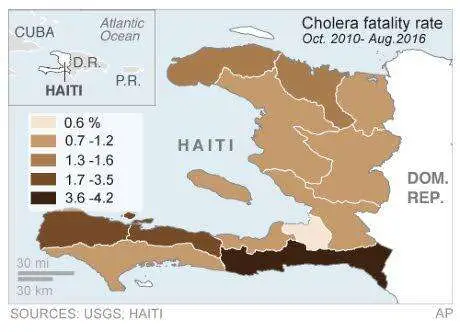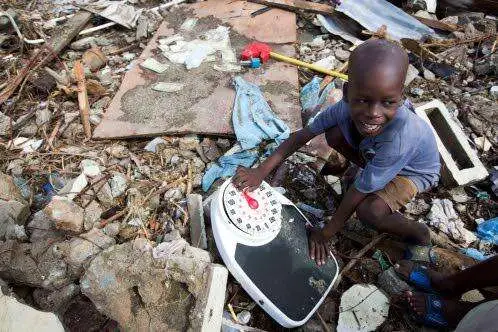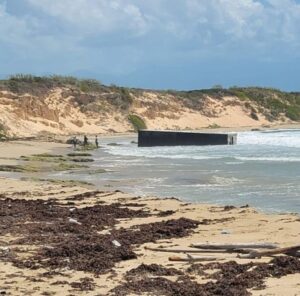
Two weeks later, Haitians still battling to overcome ravages of Hurricane Matthew
GELÃ E, Haiti (CMC) – Torrential rains on Monday brought to the fore, the extent of the humanitarian crisis in southern Haiti two weeks after Hurricane Matthew hit this French-speaking Caribbean Community (Caricom) country.
In this coastal community, where the storm surge destroyed businesses on the beach before assaulting houses further inland, a group of children and a teenager were using an old piece of plastic sheeting to try to cover a damaged roof.
But as the vehicle approached their position, the children, one of whom, naked and standing in a pool of muddy water at the foot of the ladder while making pieces of wood nailed across tree branches, makes it clear that food is their priority and not interviews or pictures.
“We want food, not pictures,” he says, matter-of-factly.
Across the unpaved road from them, 72-year-old Jean Joseph Magloire was luckier. At least he has a roof over his head, although it was not his own.
The house in another part of Gelée, where he lived since 1980, was destroyed by the hurricane, which displaced thousands of people in southern Haiti and left more than 500 dead, according to official figures.
A similar number of people are missing and presumed dead.
For the past 36 years, Magloire had lived in a “big house” he had been taking care for a doctor who, before he died, lived in Port-au-Prince, the capital of the Caricom’s only French-speaking member.
While the relatives of the late physician allowed him to continue living in the house, Hurricane Matthew decided otherwise.
When the storm destroyed the house, Magloire moved into the small dwelling with his brother and sister-in-law and their family.
But the house is small for the eight occupants, and inside they “sleep on top of each other”, Magloire tells the
Caribbean Media Corporation (CMC) in Creole outside the humble dwelling.
He said he lost everything when the storm destroyed the house.
In addition to being homeless, he does not have clean water, and the household does not have enough to eat, although food and water have been distributed in his community twice since the hurricane.
Magloire said when the food was being distributed, there was inadequate security and people just rushed the distributors, helping themselves to what they could and he got nothing.
“When food is being distributed, there should be enough security to ensure that everyone gets,” he told
CMC.
The elderly man lives in a small section of Gelée where the roads are virtually impassable. Young men, who came to the area in search food, say the other area of Gelée can be accessed by walking through the river that had separated the erstwhile “commercial” part of the community from where the residents live.
Lejier Eval, 35, a Gelée resident, who owned a restaurant on the beach, told
CMC that before the storm, he served “all classes of people”.
His menu included fish, conch, and fried pork meals and the sign on the building declared that it is “Bel Pose Bar Resto”.
The restaurant, though bolted shut, has no roof.
Eval, married and a father of one, said he plans to live off his savings, which he estimates would run out in three to four months.
He is also hoping for some assistance from his relatives even as he considers moving into rice farming as he restores his business “little by little”.
As the rains continue, vendors rush to cover rice, and other perishable items on sale on the roadside in downtown Les Cayes, where it seems that everything from fruits and vegetables, to solar panels is on sale, with a truck even selling building supplies.
On Monday, the various organisations involved in the response to the disasters in Haiti met to discuss the progress being made since the hurricane struck on October 4.
The emergency management centre has set up several working groups, each focussing specifically on one area, including Water, Sanitation and Hygiene (WASH); education; safety; logistics; health and nutrition; and food security.
“We are working closely with the COUD (district emergency operation centre) and we are trying as well to improve our relationship with the municipalities in each commune,” humanitarian affairs officer, Rachelle Elien, who emerged as the de facto chair of the meeting.
Elien said that one of the key aspects of this coordination mechanism is to identify priorities, gaps, and constraints “and to figure out in a very common way how to figure out how to solve the problems and how to respond”.
An estimated 10,000 people in the south of Haiti have been affected by the storm and two “big issues” emerged from Monday’s inter-sectoral meeting.
“We have a big gap in terms of shelter,” Elien told
CMC, adding that the Government wants the displaced people to move out of school that are being used as emergency shelters so that classes can resume.
Initially, they had wanted those displaced people to move out of the shelters by Saturday so that the school could have been repaired and cleaned for reopening on Tuesday.
The push to reopen school seems to form part of the Government to help this country, the poorest in the Eastern Hemisphere, to return to normality after the category 4 storm, the latest in a string of natural disasters to impact the country, including the devastating 2010 earthquake.
Elien said the push to reopen schools present a problem in that “if you are trying to get the people out from the shelter at the schools for the reopening of the school, the people have lost everything and they need to get something to get back home…
“And this is a very urgent situation in which we are,” she adds, noting that some organisations have targeted some communes where they can work but do not as yet have any material and supplies on the ground.
During Monday’s meeting, it was revealed that a school was being used as an emergency shelter although it did not have toilet facilities.
One disaster response official was particularly concerned about this, especially in light of the on-going cholera epidemic in Haiti, which broke out after it was imported into the country by United Nations peacekeepers after the 2010 earthquake.
Outgoing United Nations Secretary General Ban Ki-moon, who visited the country last weekend, said the fight against cholera in Haiti has been made even more difficult by the devastation caused by Hurricane Matthew.
“I deeply regret the loss of life and suffering. I wish it could have been avoided,” said Ban after visiting areas devastated by the hurricane.
The UN has since announced the launch of a new trust fund to support a coordinated system-wide response to the cholera epidemic and support the establishment of strong water, sanitation and health systems in the French-speaking Caribbean country.
The UN Haiti Cholera Response Multi-Partner Trust Fund (MPTF) is designed “to generate and manage resources to rapidly supply the UN system responses in the Caribbean country”.
The meeting on Monday discussed the possibility of using mobile toilets at the shelter, but there were also concerns about how they are to be serviced.
Matthew has affected 18 communes, and only 10 have been reached so far.
“Some of the area still now are not really accessible and we have that issues as well in terms of communicating with that these communities,” Ellen said, noting that as it relates to WASH, most of the action has been taken in the cities.
“One of the aspects we have been talking about today is about how to reach the suburbs, how to reach the peripheries in order to get the aid that we delivering,” Elien said.
Among the groups and organisations that have responded after the storm is the Barbados-based Caribbean Disaster Emergency Management Agency (CDEMA), which is into a second week in Haiti, fielding a seven-member team.
CDEMA is hoping to focus its assistance on Les Cayes, a community in which it developed an especial relationship in 1994 after its troops spent two years in the area helping to keep the peace after political unrest surrounding the removal of the then president Jean Bertrand Aristide from office.
“…The relationship with Les Cayes is a lot longer than this hurricane,” said retired Brigadier General Earl Arthurs, CDEMA’s operations specialist, who is leading the seven-member team Arthurs
In addition to Les Cayes, Caricom is hoping to assist Jeremie, another southern city devastated by Matthew.
“What Caricom wanted to do is to carve out a geographical space that we can actually see the input, the change that CARICOM would be making,” said Arthurs, adding that Caricom’s areas of focus also include agriculture, education and health.
“So this not only the hurricane response or the disaster response. This is more a longer lasting relationship,” said Arthurs, a former commander of the Belize Defence Force.
He told
CMC that the Caribbean has a lot of assets and expertise that it can give to Les Cayes to help it get is agriculture going again, including technical support, seeds and other supplies.
Over the last two weeks, Arthurs and his team has completed most of what it wanted to do to work along with the Haitian government during the emergency response period and is working toward the rehabilitation process.
The Caricom team in Haiti will supervise and record the distribution of the supplies that the community will donate which arrived on Wednesday from Jamaica.
“One of the things we in Caricom want to ensure is that whatever we bring in we can account for. So we want to see it being distributed. We want to track it from the time we procure it right through to when we hand it over and it is consumed and used by the people who need it.”
Arthurs said Caricom will send a team to ensure that this is done but will also use Haitians to assist in packaging and distributing the supplies.
Caricom’s relief supplies will include, water, food, building supplies, and food and sanitary items for children four years and under, as per Caricom’s conversation with the Haitian Embassy in Jamaica.
But while Arthurs and his team are anxious to begin distributing supplies to affected persons in southern Haiti, he was also concerned about security, saying there have been instances of young men blocking roads and demanding payment to allow vehicles to pass, claiming that they have not received any of the food being distributed.
Arthurs is in conversation with officials to ensure that adequate security is provided when Caricom begin distributing its food packages.
But Arthurs was also concerned about the weather.
“The rain, this is always a bad time, after a disaster that you lose your roof and then the rain comes tumbling down,” he said, noting that Haitian authorities have been talking about helping people to replace wood and zinc roofs rather than issuing them with plastic sheeting as a stopgap measure.
“But because of this rain, we definitely have to start off with plastic sheeting and tarpaulin because people need to stay dry and this is the quickest and easiest way and then we can go to the next stage, actually replacing their roofs.
“People could get sick and their supplies could get damaged,” he said, adding that some agencies have been distributing whole sacks of rice and beans to persons who have no safe places to put them.
“So a lot of stuff could get wet and damaged and they could lose it,” Arthurs said, noting that the conditions of the roads with the mud and muddy water could also increase health risks.
“You have the waterborne diseases and the mosquitoes that breed in the water. There are so many secondary hazards that come afterward that we have to really be on alert for.”
Amidst reports about how little some organisations have actually done with the millions they have received ostensibly to help Haiti, there is some cynicism about some of the agencies and organisations that have responded after the hurricane.
But Arthurs said Caricom will put systems in place to ensure that its assistance reaches those who need it.
“One of the things we are doing apart from monitoring, evaluating, verifying, is that we have our people on the ground all the time. We want to make sure that what Caricom puts in, Caricom can account for,” he said.
“So, unlike some of the NGOs that give stuff, we will follow it through from the time we procure it right through to when it is handed over to the individual that will receive it and use it. And that is different. We don’t just want to give it to a group that will deliver it. We want to see it delivered ourselves. So our people, the CARICOM Disaster Relief Unit, will be following the supplies all the way into the kitchen and probably take some picture of it going into the pot, and maybe even some people eating,” Arthurs told
CMC.

























